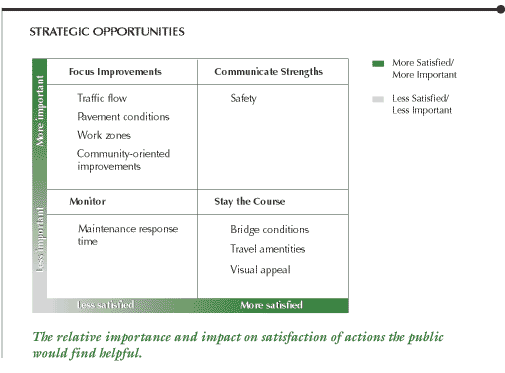|

Most travelers are satisfied with the major highways and other roadways they travel on most often. Satisfaction
with major highways, which was measured in both 1995 and 2000, has
increased substantially. The greatest strengths appear to be in
facility design and maintenance, including safety, bridge conditions,
travel amenities, and visual appeal.
highways and other roadways they travel on most often. Satisfaction
with major highways, which was measured in both 1995 and 2000, has
increased substantially. The greatest strengths appear to be in
facility design and maintenance, including safety, bridge conditions,
travel amenities, and visual appeal.
A small but growing segment of the traveling public is dissatisfied
with major
highways. Both travel delays, which are due to traffic congestion
and roadwork, and pavement conditions may contribute to this growing
dissatisfaction.
The following chart was created from the overall satisfaction levels
and importance ranking responses of those surveyed. It offers guidance
for programmatic improvements based on the public's relative
level of satisfaction and importance. The elements are:
- Focus Improvements (Higher Importance and Lower Satisfaction)
Improvements in traffic flow, pavement conditions, and work zones
may result in the greatest rise in traveler satisfaction. Work
zones are especially critical as travelers view road repairs as
a major reason for traffic delays. A stronger community focus
on the placement, design, and operation of transportation projects
can enhance community quality of life and satisfaction.
- Communicate Strengths (Higher Importance and Higher Satisfaction)
The public rated the safety attributes of major highways highly.
Information on this strength will reinforce this positive perception
and help to increase overall satisfaction.
- Monitor (Lower Importance and Lower Satisfaction)
Maintenance response time, a state and local responsibility,
is a potential issue that should be monitored closely.
- Stay the Course (Lower Importance and Higher Satisfaction)
Bridge conditions, travel amenities, and visual appeal should
be maintained as areas of strength.

Text
summary for chart
Not only does congestion contribute to dissatisfaction with roadways,
but it also affects decisions about where to live and work that,
in turn, affect patterns of community growth and development. The
placement, design, and operation of highways can affect how people
perceive the quality of life in their communities.
The study results suggest that the public would find the following
helpful:
- Improve traffic flow by expanding existing highways and public
transit and by providing better information to travelers about
traffic congestion so they can avoid it. This could involve using
intelligent transportation systems and other innovations. Building
more highways is a lower priority.
- Encourage smarter road management and operation. For example,
adopt a strategy of "get in, get out, stay out" for
both roadwork and for clearing accidents. Plan and execute effectively
so the work is done correctly and expeditiously the first time,
resulting in less traffic disruption. Also focus on quality improvements
and high performing materials to minimize the need for recurring
roadwork.
- Encourage greater understanding and awareness of how the placement
and design of highway projects can affect the quality of life
in the nation's communities. Expand community-focused alternatives
such as pedestrian walkways, bikeways, and transit.
- Focus on road safety in National Parks and Forests.
|